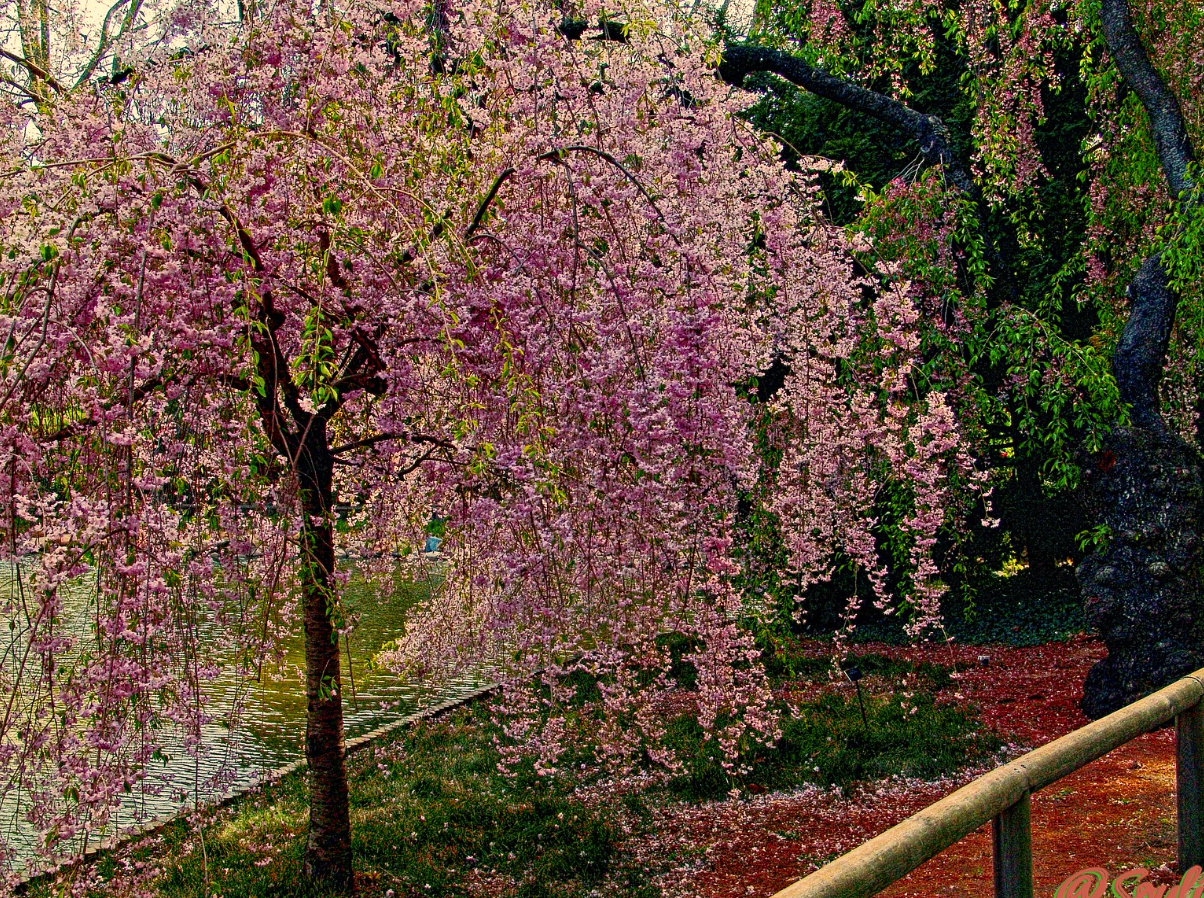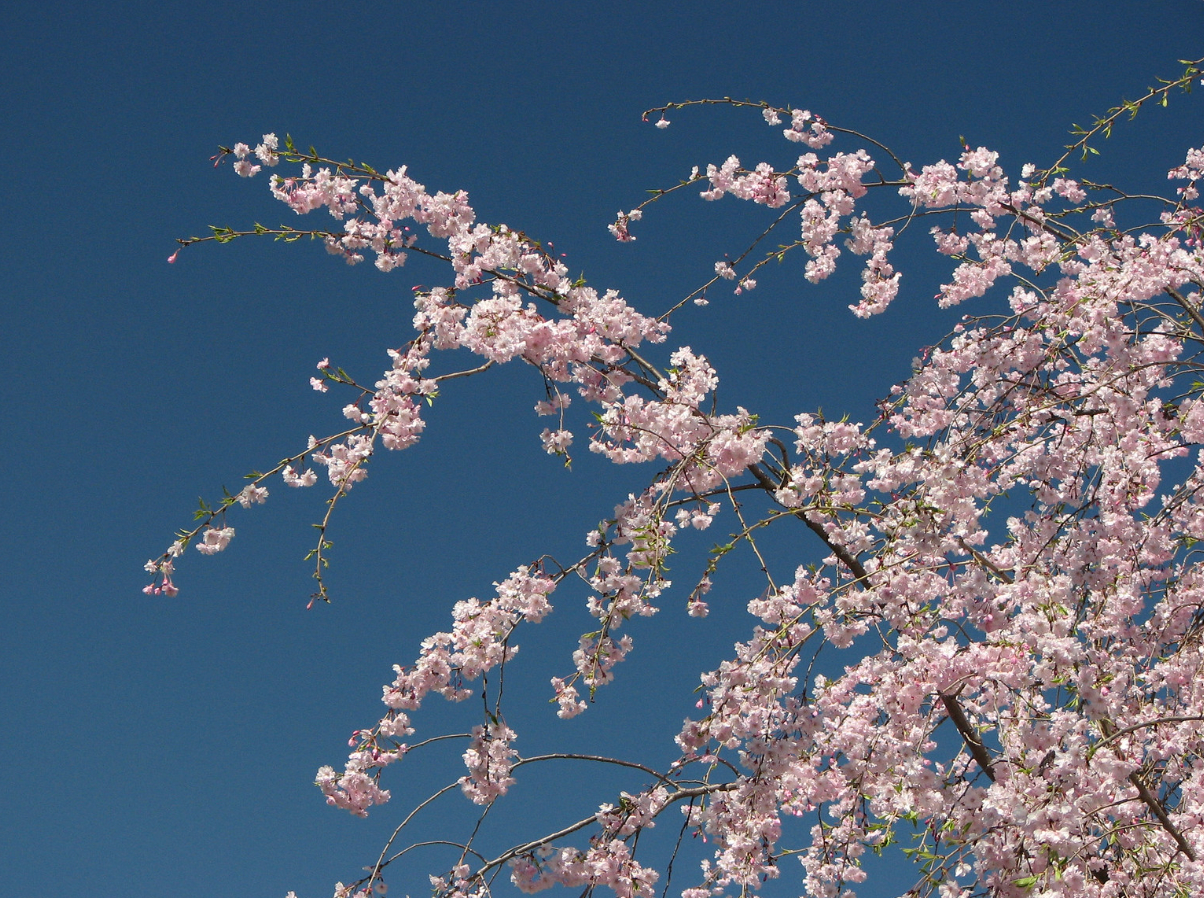Weeping Cherry Tree: Everything You Need To Know For Care

The weeping cherry tree is known for its weeping habit, pretty pink blooms, and glossy green leaves. It can grow up to 30 feet tall with a 25-foot spread. Since it's a deciduous perennial plant, the tree drops its leaves in the wintertime. It's easy to care for but will need a little extra attention during the first few years of growth. Learn how to grow weeping cherry trees below.
Fast Facts for the Weeping Cherry Tree
| Common Name | Higan cherry, rosebud cherry, spring cherry |
|---|---|
| Scientific Name | Prunus pendula |
| Harvest | N/A |
| Light | Require six hours of fun sun daily but also grows in partial shade |
| Water | Should be watered once or twice a week, or water when the top 3 inches of the soil surface are dry |
| Soil | Require a well-drained soil rich in organic matter |
| Fertilizer | Need a complete fertilizer once a year in early spring |
| Pests | Attacked by aphids, spider mites, and tent caterpillars |
| Diseases | Prone to cherry leaf spot, Cytospora cankers, powdery mildew, and twig cankers |
| Growing Zone | 5 to 8 |
Table of Contents

Everything You Need to Know to Take Care of The Weeping Cherry Tree
Weeping cherry trees were developed for two traits; the tree's cascading branches and the pink blooms. While Prunus pendula' Pendula Rosea has single pink flowers, the Prunus pendula 'Pendula Plena Rosea cultivar has double flowers.
None of these cultivars bear the sweet cherry fruit you get at your local store. Instead, the weeping cherry is an ornamental cherry tree grown for its pink flowers and weeping branches. Here's what you need to know about the tree's care and maintenance.
Planting
To plant a weeping cherry tree, make sure the planting hole is the size of the root ball. It should be about thrice as wide as the root ball too.
After digging the hole, put the weeping cherry tree in it. Lay a tool handle or yardstick across the hole to check if the trunk's base aligns with the surrounding soil.
There's no need to put in any soil amendments, as they will not allow the roots to spread outward. Instead, fill the hole with loamy soil and remove air pockets by pressing it into place.
Fill the hole halfway up. Then, water the soil until the water fills the rest of the half. Let the water drain fully. Now, add the rest of the soil to fill the top half of the hole.
When to Repot
If you grow a grafted weeping cherry tree, you can plant it directly into the soil. But if you grow from a cutting, the plant grows into a pot. In this case, you'll have to repot the plant after it outgrows the pot.
Select a pot that's about 2 inches bigger in diameter from the plant's existing container. For example, if you initially planted the weeping cherry plant in a 4-inch container, select a 6-inch container for the subsequent year.
When the flowering cherry tree is about 5 feet tall, you can plant it in your yard. Your tree will take about a decade to grow to full size.
Weeping cherries have a lifespan of about 30 to 40 years. So, you must select a good spot for them where they can thrive for decades to come.
Care and Maintenance
There are many varieties of the weeping cherry tree, such as the Japanese weeping cherry tree, the dwarf weeping cherry tree, and the pink weeping cherry tree. The care requirements for most of these cultivars are the same.
Sun and Temperature
A regular or dwarf weeping cherry tree needs at least 6 hours of direct sun daily. You can also increase sun exposure to 8 hours for better flower production.
Although the tree does not mind some shade, excessive shade will affect flower production and color. Most varieties are hardy to Zones 5 to 10 since they need a cold winter period.
Weeping cherry trees must get anywhere from 700 to 900 hours of cold temperatures below 45 degrees Fahrenheit to break dormancy. Only then can the tree bloom in the spring.
Water and Humidity
Although older pink weeping cherry trees can live through dry spells, young trees need ample watering. When planting the tree, give it enough water for the root ball to establish.
Once that happens, water the tree once or twice a week to soak the soil's top surface. Weeping cherry trees growing in dry regions benefit from drip irrigation. You can also put mulch around the tree's base to retain moisture. However, place the mulch at least 3 inches away from the trunk's base so that it doesn't come in contact with the tree.
High humidity is a no-no for weeping cherry trees. A combination of poor soil drainage and high humidity can result in fungal disease.
Soil
Although weeping cherry trees do well in most soil types, loamy soils are the best for their growth. The soil should also have good drainage to prevent water accumulation, which can cause root rot. There are no special requirements for soil pH, though. Neutral pH works for weeping cherry trees.
Fertilizing
A weeping cherry blossom tree doesn't necessarily need soil amendments or fertilizers. But you can add organic material or compost to the soil for added nutrition.
If you want to give your tree a growth boost, a complete fertilizer at the start of the growing season. A complete fertilizer has all macronutrients: nitrogen, phosphorus, and potassium.
Opt for a balanced fertilizer with an equal ratio of these compounds. Follow the instructions on the fertilizer packaging to determine the amount to use.
Pruning
A regular weeping cherry tree does not need pruning, and the same is true for a dwarf weeping cherry tree. However, you might want to prune your tree to improve circulation.
The best time to prune a weeping cherry tree is during winter since it's dormant. Do not prune during spring or when the tree has flowers on it.
Here are some simple rules for pruning a weeping cherry tree:
- Prune any broken or dead branches.
- Cut upright growing branches. Since it's a weeping tree, the branches are supposed to grow in a weeping manner. Some branches may grow upright and will continue to grow so. Remove them to maintain the tree's weeping habit.
- Remove diseased branches. If the tree has been infected by a pest or a fungal disease, remove the affected branches so that the problem does not spread to adjacent healthy limbs.

Propagation
You can propagate a pink weeping cherry tree through cuttings or seeds. The latter takes quite long since weeping cherry tree seeds can take 4 to 12 months to germinate.
Propagating the tree from a cutting is quicker. You should take a cutting from new summer wood. It must have about 3 to 4 nodes. Here's how to propagate the cutting:
- Take a sharp knife and cut a 1-foot branch from the tree.
- Make a 1.5-inch-long diagonal cut at the bottom (the part that was connected to the tree) of the cutting.
- Apply a rooting hormone to the cut.
- Plant the cutting in a pot and water it well to promote root growth.
Did you know? When the flowers fall, it looks like snow on the ground. This plant is for ornamental use only, not to grow cherries.
Common Issues With Weeping Cherry Trees
A flowering weeping cherry tree is usually easy to care for, but that doesn't mean it's not prone to pests and diseases. You must know about these problems to take immediate action in case disease symptoms arise.
Growing Problems
The main issue with weeping cherry growth most people see is the lack of pink flowers. If your tree is not flowering, it might be due to one of two reasons.
First, the tree might not be mature enough. A flowering cherry tree produces pink flowers in the fifth year of growth. Some trees may take 7 years to bloom.
Second, your tree isn't getting enough sunlight. At least 6 hours of full sun is important for the tree to flower properly. While more sunlight is better, anything lesser will impact flower production.
Here are some other growing problems of the weeping cherry tree.
Gummosis
Gummosis is a condition where sticky, gummy sap starts oozing out of the tree's trunk and branches. There are two reasons this may be happening:
- Overwatering: If irrigation or rain saturates the soil with water, gummosis might occur.
- Borers: Peach Tree borers cause gummosis of the lower part of the trunk. The tree produces gum to protect itself from the borers.
Cankers
Cankers are dead patches that form on the trunk of the tree. They can be caused by various fungi and bacteria, including Cytospora canker.
Mulching can help manage cankers. You should also water your plant regularly and prune any drying or diseased branches quickly.
Physical Damage
Weeping cherry trees are also susceptible to physical trunk damage from vole feeding, weed trimmers, and lawnmowers. When mowing the lawn, make sure you do not damage your tree's trunk.
Always sanitize your pruning tools before using them on healthy branches. Otherwise, the fungal spores can transfer from the diseased branches to the healthy parts of the plant.
Wildlife
Wildlife, such as deer, like to feed on ornamental cherry trees. Apply deer repellants if you live in an area with a large deer population. You can also hang deodorant soap cakes from the tree's branches to keep wildlife away.
Place hardware cloth around the lower part of the trunk to protect it from voles. The cloth should extend at least 2 to 3 inches underneath the soil level.
Pests
A pink weeping cherry tree can attract many pests. Some of them are discussed below.
Spider Mites
Belonging to the Tetranychidae family, spider mites affect flowering trees. Although these insects feed on plants all year long, they affect deciduous trees like the weeping cherry tree in spring or when the weather is warm enough for reproduction.
These pests reproduce from June to September. If they find favorable reproduction and growth conditions, they can create a whole new population in just a week.
That's why it's important to deal with a spider mite infestation quickly. These pests suck the plant's sap, turning the leaves red or yellow.
Since they are "spider" mites, they also form webs on the foliage. You'll notice webbing over the twigs and leaves of your weeping cherry tree.
The best prevention strategy for a spider mite infestation is proper watering. They are more likely to affect water-stressed trees.
If the infestation occurs, you can manage it with water sprays and insecticidal oils. Some insecticidal soaps may also work against these annoying pests.
Japanese Beetles
Japanese beetles are small invasive insects that affect weeping cherry trees in large numbers. They feed on the pink flowers and the plant's leaves.
If present in abundance, these pests can damage your weeping cherry tree to a point where most of the leaves defoliate. A good management tip is to keep an eye on the tree for signs of Japanese beetle infestation.
Some of them include:
- Brown patches on the leaves
- Skeletonized foliage
- Flowers turning brown and falling off
An increase in the number of Japanese beetles also brings other animals like armadillos, moles, skunks, and birds to your garden. These animals feed on the larvae of Japanese beetles.
Spray your tree with pyrethrin to eliminate the bottle population. You can also use milky spore powder to control the beetle grub population.
Borers
Like all other flowering trees, weeping cherries are also susceptible to borer infestations. These are a group of insects that feed on the plant's branches and roots.
Many experts believe borers to be secondary infestations. It means your tree is already exposed to an insect or some sort of stress.
Plants affected by transplanting shock, repeated defoliation, or drought are prone to these insects. The management strategy for borers is to deal with the underlying cause of stress.
You can also prune the branches that have been damaged by borer infestation. Another way to manage the issue is by applying horticultural oils to the affected part of the tree.
Diseases
The good news about weeping cherry trees is that they do not attract many pathogens. However, some fungi can affect the plant. Some diseases of the weeping cherry tree include the following.
Cherry Leaf Spot
Cherry leaf spot results in spot formation on cherry trees. These spots begin as purple marks on the older leaves during summer. With time, they become 1/4-inch big and change color to red-brown.
Often, many spots grow together to form a big brown dead patch. You'll also see yellow areas surrounding the spots.
Spotted leaves fall off the tree in just a month after infection. The fungus that causes cherry leaf spot, Blumeriella jaapii, overwinters and spreads through the fallen leaves. Even when the leaves die, the fungus inside them survives.
In early spring, the fungus grows as the temperatures rise. It starts producing spores that spread through the air onto healthy leaves.
Here's how to manage cherry leaf spot:
- Remove the infected leaves that fall at the base of the tree.
- Apply fungicide onto weeping cherry trees two weeks after the initial pink flowers appear. Reapply the fungicide in the growing season based on the manufacturer's instruction about the frequency of application.
- Use captain or myclobutanil-containing fertilizers to protect weeping cherry tree leaves from cherry leaf spots.
Powdery Mildew
Powdery mildew is another fungal infection that affects flowering cherry trees. Although it doesn't cause severe damage, it can affect the tree's aesthetic. However, in cases of a severe infestation, the disease can stunt the plant's flowering and growth.
Some symptoms of powdery mildew are:
- Cobwebs and powder on infected plants
- White powdery spots on the stems and leaves
- Blotches on buds stems, and leaves
- Purple or red leaves
- Distorted leaves (mostly younger leaves)
Powdery mildew mainly affects weeping cherry trees growing in shaded areas. Poor air circulation also allows powdery mildew to thrive.
Unlike many other leaf-affecting fungi, powdery mildew does not require moisture on the leaves to thrive. Its spores simply spread through the air to affect healthy leaves. Some management tips include:
- Planting resistant varieties. Opt for disease-resistant weeping cherry tree varieties to prevent infestations.
- Reducing humidity. Prune the tree's canopy to thin the foliage so that there's sufficient air circulation. Also, put mulch around your weeping cherry tree.
Sweet New Earth's Final Word On The Weeping Cherry Tree
Our favorite variety is the pink weeping cherry tree. Anything with pink flowers gets us going, especially with an ornamental cherry tree. Many homeowners love the dwarf weeping cherry tree because it's a but easier to handle than some of the giant varieties. If you want to grow weeping cherry tree, be sure to follow this guide but if you want to plant other trees then check out some of our other tree care guides.
FAQs

Christina Hernandez
Christina has done most of her research on environmental science but recently has changed her focus towards sustainable forestry. She has a passion for the outdoors and wants to spread that passion to the world.
Join our community!
Join to receive guides, insights, and the latest gardening deals!
